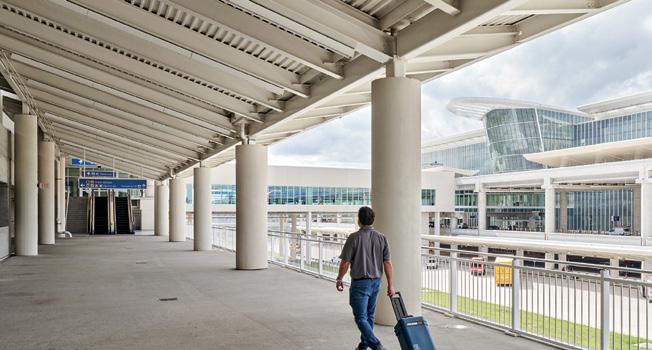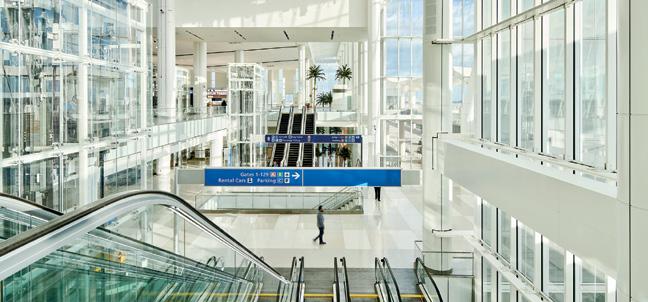
3 minute read
TEAMWORK AND INNOVATION DELIVER SUCCESS
The teamwork, innovations and efficiencies demonstrated by the project team allowed Terminal C’s doors to open by the target date of September 2022:

• Multiple stakeholder needs: From a security standpoint, the TSA and CBP needed to control their environments and restrict access while building codes insisted on creating freedom of movement and accessibility. Working closely with both TSA and CBP leaders, the Authority and its owner’s representative, the team created solutions and amenities that enhanced the passenger experience while meeting the agencies’ standards and building codes.
• Complex delivery elements: Components of the terminal were delivered under the fast-paced schedule dictated by the rapid growth (and recovery from COVID’s downturn) using two construction management at risk (landside and airside) teams, a design-build-operate maintain baggage team, standard design-bidaward contracts and multiple design-build concession/tenant packages to successfully deliver the program, which were all presented with significant challenges along the way. For example, the Authority expanded and contracted the project scope three times to meet the needs of passengers and airlines. Due to the rapid growth MCO was experiencing, the Authority added four more gates for a total of 19 while in the middle of construction of the initial 15 gates. When the pandemic hit, the Authority deferred the expansion. With concept designs already in a 3D building information model, the jointventure construction manager and HNTB made adjustments on the fly. And when airport traffic returned to pre-COVID-19 levels, the additional gates were added back to the scope as Phase 1X.
“The entire team has been the best I’ve ever worked with in 32 years of being in this industry,” said Davin Ruohomaki, former GOAA senior director of construction and engineering. According to Brooks, the Authority’s decision to put all project partners together on-site early in the process made the difference. “It enhanced communication and ensured accountability,” he said.
• A pandemic: As architect of record, HNTB oversaw 41 subconsultants, seven of which were selected by the Authority, and kept the project advancing.
“We adapted,” Arteaga said. “Bill and I were always at the job site because we needed to be present. Everyone else worked from home, and we conducted virtual meetings during COVID.”
The construction process also gained efficiencies through an all-electronic permitting process the City of Orlando implemented on the job site. Additionally, HNTB integrated a tracking tool into the project, which enabled the team to efficiently document and log decisions.
“HNTB was right there to answer questions, determine the evolution of the design, keep up with all the requests for information and submittals from the contractors and coordinate with the regulatory body, TSA and CBP. Having them be a complete stakeholder with us helped deliver the project within the scope, budget and schedule,” Ruohomaki said.
“MCO already is a world-class, global gateway to the most visited destination in the U.S., but the addition of Terminal C makes it one of the most visionary, innovative airports in the country,” Brooks said. “Our focus was on delivering the passenger experience vision that GOAA established.”

Part of what makes the terminal so innovative is its flexibility to change as airline and passenger needs change. Common-use facilities allow airlines to operate out of any gate for any length of time. All 15 swing gates can handle both international and domestic flights and can accommodate up to 20 aircraft, including narrow body, jumbo and super-jumbo jets.
To meet the increasing demand for air travel, GOAA has already activated Phase 1X of the project. The new phase will add four more innovative gates, bringing the terminal’s total to 29 aircraft on 19 gates. In its current configuration, the new 1.8 million-squarefoot terminal enables MCO to serve an additional 10–12 million passengers annually. At full buildout, Terminal C can house up to 120 gates and serve 60 million passengers annually.
“Terminal C is open, and what a benefit it is to the community,” says Kevin Thibault, chief executive officer of the Greater Orlando Aviation Authority.

“This state-of-the-art terminal is leading the way to a truly intermodal future for all of central Florida, where passengers will be able to take a plane, a train or an automobile from one location. The vision has become reality.”
Passenger experience delivered Built on a foundation of communication, collaboration and coordination, the successful completion of Terminal C represents the largest expansion in the history of Orlando International Airport and the next phase of HNTB’s partnership in serving GOAA as it continues its ascension as a leader among the world’s airports. n
Contacts
BILL BROOKS, PE, HNTB Senior Program Director (407) 825-1589 n wbrooks@hntb.com
JUAN “J.C.” ARTEAGA, AIA, NCARB, CGC, CBO, LEED®AP BD+C, HNTB Architect of Record (407) 825-1588 n jcarteaga@hntb.com
Pointing the way
To locate the nearest mother’s nursing station or service animal relief area, passengers can access Terminal C’s Bluetooth wayfinding beacons. The beacons communicate with smartphones to provide detailed, turn-by-turn digital navigation throughout the terminal.










